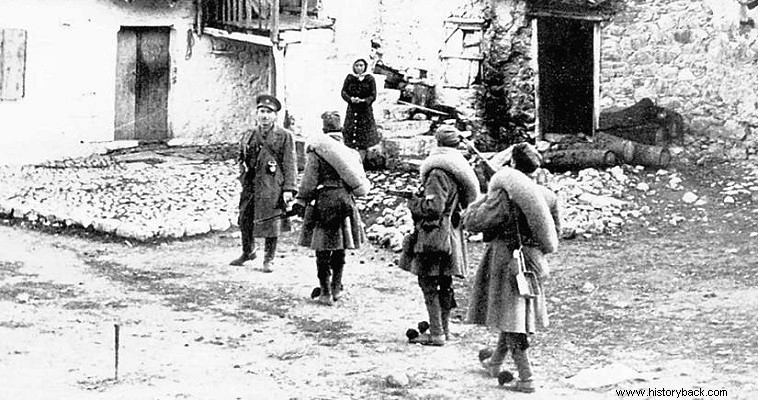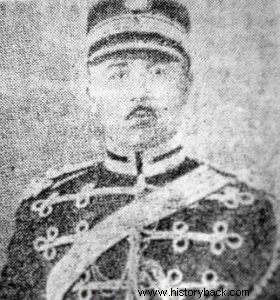
The security battalions began to be formed in 1943, when the occupying government of I. Ralli realized that ELAS was trying to bring the country under its control, sidelining or even eliminating the other resistance organizations. Much has been said about these controversial sections indeed. The battalions are presented by the left, to this day, as treasonous organizations that collaborated with the conqueror, in the same way that in the past they were presented almost as national organizations.
As is almost always the case, the truth lies somewhere in the middle. And if this axiom applies in general, it applies even more to the case of the Sparta "Leonidas" Security Order. The occupation of Greece by the Axis powers not only did not extinguish, but on the contrary strengthened the spirit of resistance of the Greeks. This spirit was a consequence of the proud victories the Army had achieved against the Italians, but also of its heroic resistance to the Germans. The spirit of the front was kept alive. Thus the resistance of the Greeks against the conquerors began automatically and immediately throughout the country, depending on local possibilities and conditions.
In the Peloponnese in particular, ELAS rebel groups gradually developed. The situation was turned upside down by the movement of the Greek leader Telemachus Vrettakos, who on his own initiative formed a resistance organization, which was also recognized by the exiled Greek government in Cairo. Ilarch Vrettakos had initially joined the EAM, but he gradually realized that this also served the political purposes of the KKE leadership, beyond its national liberation character. Right from the start, however, the movement of Ilarch Vrettakos found itself against ELAS and it also found it against it.
The ELAS leadership wanted to monopolize the national resistance. We must not forget that in that same period (autumn 1943) the civil war had already started in the Greek mountains, with ELAS attacking both EDES and the EKKA of the heroic Psarros. In the same way, ELAS viewed Vrettakos' movement with hostility from the beginning, which was largely embraced by the basically conservative people of Laconia. As the organization of Vrettakos grew stronger, the hostility of ELAS increased. Vrettakos had managed since June 1943 to expand the network of his organization throughout Laconia.
Because Brettakos lacked armaments he contacted the allied headquarters in the Middle East from which they promised to supply him with armaments. The weapons would be dropped from airplanes on the nights of August 10, 11, and 12, 1943. The site was designated as the Royal Taygetus area. ELAS, however, was informed of everything and made a surprise attack against Vrettakos and his men who were waiting for the weapons. In the battle that followed, most of Brettakus' men, led by him, managed to escape.
Two men of Vrettakos who were captured, the physician Sakellaridis and the fighter Liarakos, were taken to a nearby temple where they were brutally executed. Afterwards, ELAS began to persecute Vrettakos with the aim of definitively disbanding his organization. He finally managed to trap the hilarcho and his men on October 27, outside Kalamata, in Paleochori. A two-day battle was fought there, but with a predetermined result.
Vrettakos and 17 of his men were captured and murdered. After the physical extermination of Vrettakos, ELAS unleashed a wave of terrorism against all involved with the organization, which gradually extended to all those not ideologically identified with it. Then the first concentration camps began to operate in the Peloponnese where all the "enemies of the people" were locked up.
Composition decision
After the extermination of Vrettakos there seemed to be no obstacle to the complete dominance of ELAS in Laconia. The terrified Laconians would not dare to question the sovereignty of ELAS, even if they did not agree with it. Sources opposed to EAM-ELAS speak of an orgy of terrorism at the expense of opposing citizens. ELAS, after exterminating Hilarch Vrettakos, proceeded to arrest his brother Leonidas.
L. Vrettakos was locked up in the Anavrytis concentration camp and would be executed, if he did not manage to be released on the appointed day of his execution by a group of his dead brother's men from the village of Soha, led by Leonidas Papadakos. Papadakos' men elected Leonidas Vrettakos as their leader and, forming a rebel group, fled to Taygetos. This was the founding act of the "Leonidas" order.
In this climate, the idea of creating a volunteer battalion of national guard began to be born, which would have as its goal the protection of citizens from the arbitrariness of ELAS. In the anti-Eamian circles, led by Leonidas Vrettakos, brother of the unjustly murdered hilar Telemachus Vrettakos, the idea of starting an armed struggle against EAM-ELAS prevailed. The Germans were seen as secondary enemies, since the collapse of the Axis had already begun – Italy had capitulated in September 1943 and German forces were in constant retreat on all fronts.
It was now purely a matter of time for the Germans to withdraw from Greece, they believed that what had to be done primarily was to overthrow the EAM-ELAS plan for the communistization of Greece. These thoughts were catalyzed by the thirst for revenge for wronged blood, in accordance with the ancient Maniac custom of vendetta.
From the above, however, it becomes clear that the "Leonidas" battalion was not formed, according to its basis, by opportunistic elements aimed at obtaining benefits from the conqueror. Its core was made up of consciously anti-Eam people, most of whom had serious personal reasons to detest EAM-ELAS. This qualitative differentiation in relation to many enlisted in the other security battalions that were formed around the same period.
After his rescue, Brettakos with his seven men tried to reconstitute his brother's organization, the cores of which were left in Sparta and Gytheon. Soon the organization began to grow by reorganizing its network in Soha and Mystras. However, ELAS attacked Mystras, kidnapping 12 residents, including the two minor children of the organization's executive D. Dimitrakakis.
ELAS also attacked within Sparta, at the house of Vrettakos, whom of course he did not find there. However, he found Georgios Kargakos, a friend and comrade-in-arms of Vrettakos, whom he killed. A new ELAS attack on Mystras followed. This time the persecuted had left and so the ELASites were limited to setting fire to their houses. And all these events happened before the formation of the "battalion of the Germans". Only after the departure of L. Vrettakos, in 1944, the battalion deviated to the more pro-German side.

The deceased ilarch Vrettakos.
